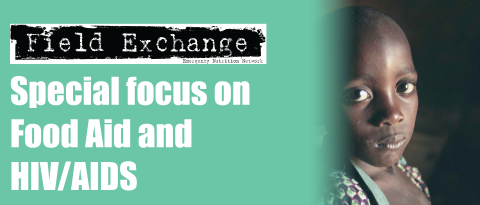Letter on micronutrient powders, by Stacia Nordin
Dear Field Exchange,
In 2004 I attended a presentation on Sprinkles, a micronutrient powder that can be 'sprinkled' onto foods. The development of the product was supported by several large organizations in a not-for-profit manner over the past several years. It wasn't the first time I'd heard about the product as the group approached some organizations in Malawi a year or two before to explore bringing the product here. Now, in 2005, a message was posted to the ProNut HIV listserv - which links those concerned with nutrition and HIV/AIDS - that the product aims to make it into all the homes of vulnerable populations.
I'm not at all opposed to sprinklestypes of products or other nutrient pills for treatment (or in other special situations), as long as recipients are also educated about where the nutrients come from in food. But once again, a message is being sent that nutrition comes from a pill/a packet, a foreigner, and all with money.
It is too bad that all that research, time, energy and money couldn't teach people (or local manufacturers) how to make their own sprinkles from local nuts, fruits, greens, oilseeds, insects, fish, and the like. Instead of just sprinkling a packet onto a bulky carbohydrate food, use the sprinkle as treatment along with teaching about planting and eating less of that bulky carbohydrate in the first place.
The results could be just as immediate and dramatic, but with an impact that could last for generations to come. The organisations that support this type of permanent intervention could be mentioned during every teaching session along with big banners and flyers that announced them as the inventors and /or supporters. Just imagine a nice sprinkle powder that everyone can have on hand to improve their own nutrition without relying on a packet from an outside source that is manufactured with machines and jetted in with thousands of litres of petrol.
I'm sure that pre-packaged, sourcedfrom- far-away products have their place in wars, tsunamis, a few cities and other disasters, but for the majority of the 750 million children in the developing world, their own indigenous foods would have just as much effect with a longer-term impact on the society's nutritional health.
When I saw the developer of this product do a presentation on it, he did include a sentence about diversifying diets as part of the whole project, but it was strongly overshadowed by bringing in external resources and experts. When I asked him about using the same resources that went into developing, manufacturing and transporting Sprinkles to create a local 'sprinkle' product with an emphasis on local diversified diets, he immediately responded that it wouldn't work.
How do we know if no one really puts the effort into it at the level that products, like Sprinkles, get?
Stacia Nordin, RD
Nutrition Consultant: Specialist in food security, sustainable agriculture, HIV/AIDS PO Box X-124, Post Dot Net Crossroads, Lilongwe, Malawi, email: nordin@eomw.net
Zlotkin S, Schauer C, Christofides A, Sharieff W, Tondeur M,et al, (2005) Micronutrient sprinkles to control childhood anaemia. PloS Med 2 (1): e1. Source: PLoS MEDICINE, an open access, freely available international medical journal. http://www.plosmedicine.org
Imported from FEX website


